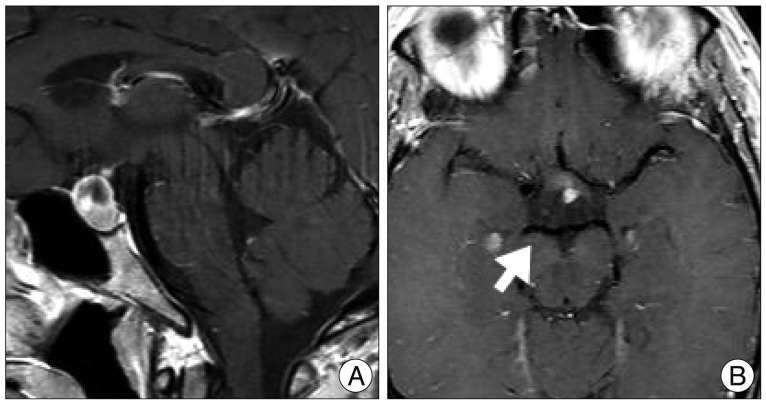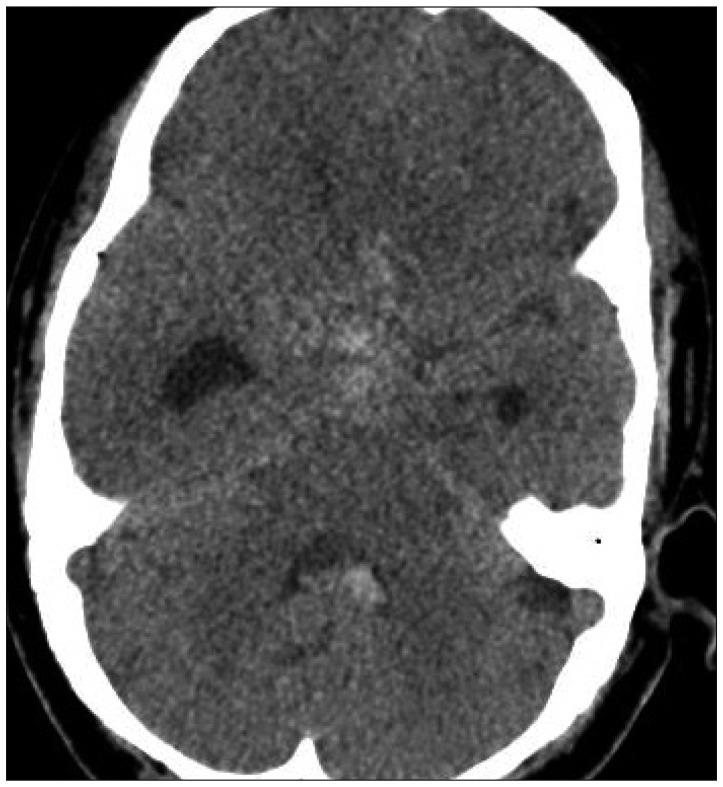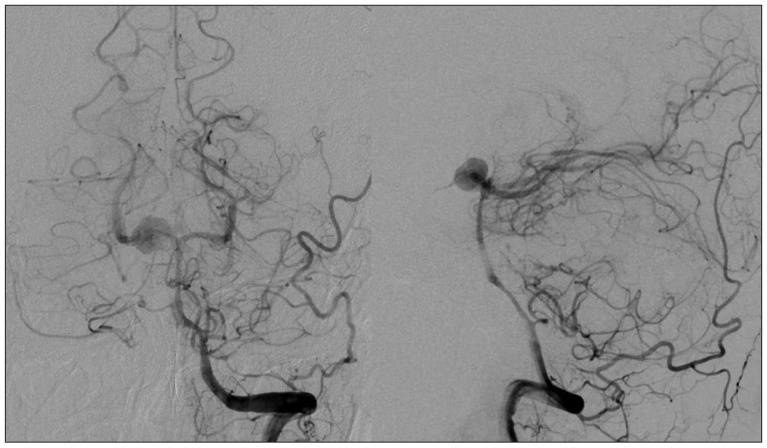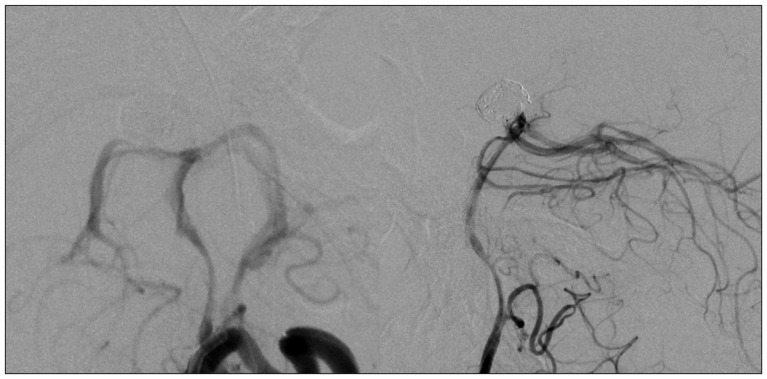J Korean Neurosurg Soc.
2014 Mar;55(3):160-163. 10.3340/jkns.2014.55.3.160.
Large Intracranial Aneurysm after Transsphenoidal Surgery for Pituitary Macroadenoma
- Affiliations
-
- 1Department of Neurosurgery, Dankook University College of Medicine, Cheonan, Korea. lsk999999@gmail.com
- KMID: 2191083
- DOI: http://doi.org/10.3340/jkns.2014.55.3.160
Abstract
- Uncontrolled cerebrospinal fluid (CSF) leakage after transsphenoidal surgery (TSS) for pituitary adenoma can lead to meningitis. Intracranial mycotic pseudoaneurysm is a rare complication in central nervous system infection. Large single pseudoaneurysm is more uncommon. Most mycotic aneurysms occur due to endocarditis. The present patient had no heart problem and was infected by CSF leakage after transsphenoidal surgery. We present a case of large ruptured mycotic pseudoaneurysm as a complication of cerebral infection after TSS for pituitary macroadenoma.
MeSH Terms
Figure
Reference
-
1. Asai T, Usui A, Miyachi S, Ueda Y. Endovascular treatment for intracranial mycotic aneurysms prior to cardiac surgery. Eur J Cardiothorac Surg. 2002; 21:948–950. PMID: 12062301.
Article2. Berker M, Hazer DB, Yücel T, Gürlek A, Cila A, Aldur M, et al. Complications of endoscopic surgery of the pituitary adenomas : analysis of 570 patients and review of the literature. Pituitary. 2012; 15:288–300. PMID: 22161543.
Article3. Brust JC, Dickinson PC, Hughes JE, Holtzman RN. The diagnosis and treatment of cerebral mycotic aneurysms. Ann Neurol. 1990; 27:238–246. PMID: 2327735.
Article4. Cappabianca P, Cavallo LM, Colao A, de Divitiis E. Surgical complications associated with the endoscopic endonasal transsphenoidal approach for pituitary adenomas. J Neurosurg. 2002; 97:293–298. PMID: 12186456.
Article5. Chapot R, Houdart E, Saint-Maurice JP, Aymard A, Mounayer C, Lot G, et al. Endovascular treatment of cerebral mycotic aneurysms. Radiology. 2002; 222:389–396. PMID: 11818604.
Article6. Chun JY, Smith W, Halbach VV, Higashida RT, Wilson CB, Lawton MT. Current multimodality management of infectious intracranial aneurysms. Neurosurgery. 2001; 48:1203–1213. discussion 1213-1214. PMID: 11383721.
Article7. Corr P, Wright M, Handler LC. Endocarditis-related cerebral aneurysms : radiologic changes with treatment. AJNR Am J Neuroradiol. 1995; 16:745–748. PMID: 7611032.8. Frazee JG, Cahan LD, Winter J. Bacterial intracranial aneurysms. J Neurosurg. 1980; 53:633–641. PMID: 6893602.
Article9. Hara Y, Hosoda K, Wada T, Kimura H, Kohmura E. Endovascular treatment for a unusually large mycotic aneurysm manifesting as intracerebral hemorrhage - case report. Neurol Med Chir (Tokyo). 2006; 46:544–547. PMID: 17124370.
Article10. Jagetia A, Rajan S, Sinha S, Singh D. Fatal epistaxis from the fetal posterior communicating artery--a delayed complication of trans-sphenoidal surgery. J Clin Neurosci. 2010; 17:656–658. PMID: 20189396.
Article11. Kadyrov NA, Friedman JA, Nichols DA, Cohen-Gadol AA, Link MJ, Piepgras DG. Endovascular treatment of an internal carotid artery pseudoaneurysm following transsphenoidal surgery. Case report. J Neurosurg. 2002; 96:624–627. PMID: 11883853.
Article12. Masuda J, Yutani C, Waki R, Ogata J, Kuriyama Y, Yamaguchi T. Histopathological analysis of the mechanisms of intracranial hemorrhage complicating infective endocarditis. Stroke. 1992; 23:843–850. PMID: 1595103.
Article13. Monsuez JJ, Vittecoq D, Rosenbaum A, Goujon C, Wolff M, Witchitz S, et al. Prognosis of ruptured intracranial mycotic aneurysms : a review of 12 cases. Eur Heart J. 1989; 10:821–825. PMID: 2806280.
Article14. Nakahara I, Taha MM, Higashi T, Iwamuro Y, Iwaasa M, Watanabe Y, et al. Different modalities of treatment of intracranial mycotic aneurysms : Report of 4 cases. Surg Neurol. 2006; 66:405–409. discussion 409-410. PMID: 17015123.
Article15. Nakata Y, Shionoya S, Kamiya K. Pathogenesis of mycotic aneurysm. Angiology. 1968; 19:593–601. PMID: 5695978.
Article16. Pruitt AA, Rubin RH, Karchmer AW, Duncan GW. Neurologic complications of bacterial endocarditis. Medicine (Baltimore). 1978; 57:329–343. PMID: 580794.
Article17. Raymond J, Hardy J, Czepko R, Roy D. Arterial injuries in transsphenoidal surgery for pituitary adenoma; the role of angiography and endovascular treatment. AJNR Am J Neuroradiol. 1997; 18:655–665. PMID: 9127026.
- Full Text Links
- Actions
-
Cited
- CITED
-
- Close
- Share
- Similar articles
-
- Treatment of Cushing’s disease with macroadenoma through transsphenoidal surgery
- Incidental Superior Hypophygeal Artery Aneurysm Embedded within Pituitary Adenoma
- Pituitary Apoplexy due to Pituitary Adenoma Infarction
- Validation of Simultaneous Endoscopic Sinus Surgery and Transsphenoidal Surgery in Patients with Chronic Rhinosinusitis and Pituitary Tumors
- Clinical Analysis of Pituitary Macroadenoma by Transsphenoidal Approach





